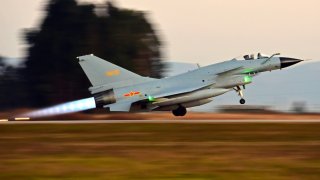The Chinese J-10 Has Some Deadly Limitations
The J-10 was a light single-seat multirole aircraft meant to replace older J-7 and J-8 aircraft as the bulk of forces a possible adversary would meet.
Here's What You Need to Remember: While the constant redesign of the J-10’s intake and fuselage belies the fact that at the core the aerodynamic design is less mature, these drawbacks would not prove to be as much of a problem if the aircraft remains at range and slings missiles.
In the 1990s, China introduced its answer to the MiG-29 and F-16. The J-10 was a light single-seat multirole aircraft meant to replace older J-7 and J-8 aircraft as the bulk of forces a possible adversary would meet.
When China started to reopen itself to the world in the 1980s, the PLAAF realized how obsolete its fleet of J-7 and J-8s were going to be. As a result, Deng Xiaoping began work on a new light tactical fighter. The performance was meant to be better than the J-8II and MiG-23 and “equal” to the F-16, which was cutting edge when development was started.
As with most Chinese projects, the development of the J-10 was not just an exercise in making an aircraft, but the program also aimed to develop several key technologies. Improved manufacturing techniques, fly-by-wire controls, and canards in the design were all things China wanted to improve in the J-10.
Different from the MiG-29 and F-16, the J-10 featured a large delta wing reminiscent of the French Mirage series of fighters. However, unlike the Mirage, it featured two canards right behind the cockpit to grant it increased maneuverability. Like the Mirage 2000, the J-10C is designed to have relaxed stability, so it can have a large delta wing and remain nimble.
Also unlike the Mirage, which featured the intakes for the jet engine on the left and right side of the fuselage, the J-10 had one solitary intake underneath the cockpit, like the F-16. The J-10A’s intake is boxier and has differing design details from the F-16 intake.
As China lacked the technology to build its own advanced jet engines when the J-10 was being built, the intakes lead to a Russian-built engine: the AL-31. This engine was originally designed for the Su-27 “Flanker” for use in a pair, but in the J-10 it operates as a single unit.
Weapons wise, the J-10 was fairly conventional for a multirole fighter of its era. It features three weapon pylons on each wing and three on the belly, giving it similar potential loadouts to the MiG-29 and F-16. Recently J-10s commonly been seen with the GDJ-5 twin munition adapter to increase the amount of ordnance carrying hardpoints to 11. These pylons utilize NATO standard connections, so they are physically compatible with a wide range of Air-to-Air and Air-to-Ground munitions.
Radar wise, the J-10A uses a mechanically scanned KLJ-3 radar. This was upgraded to a PESA version of the same set on the J-10B, and to an AESA with an unknown designation in the J-10C.
As the J-10A was fairly obsolete when it was introduced, it was quickly followed up by the J-10B, which improved the avionics, redesigned the jet engine intake to be taller and rounder, upgraded the engine to the improved AL-31FN variant. An IRST system was also integrated. However China has been slow to upgrade its fleet to the new J-10B standard, and the majorities of J-10 in service are still J-10As.
The latest variant of the J-10 is the J-10C, which upgrades the avionics and features jet another new jet engine intake (indeed the easiest way to identify a J-10 is to look at the intake), this time wrapping around the upper part of the fuselage. The J-10C can also fire the new Chinese air-to-air missiles, which include some advanced long range active-radar homing designs.
The future of the J-10 remains doubtful. The J-11 is far more capable in most aspects than the J-10 and has more potential for development, and China appears to be continuing R&D and developing that fighter. The J-10C is currently more capable in the air-to-ground realm as a result of its usage of NATO standard pylons, but this may change in future versions of the J-11.
China is also producing two types of stealth fighter: a light and a heavy design similar to the US. Just as the F-35A will replace the F-16 in American service, the FC-31 might replace the J-10 in the Chinese service.
Despite this, the J-10 is not to be underestimated. As China puts more advanced indigenous radars and integrates new AESA radars on it, it could remain a credible threat, just as the F-16V remains relevant on the modern battlefield.
While the constant redesign of the J-10’s intake and fuselage belies the fact that at the core the aerodynamic design is less mature, these drawbacks would not prove to be as much of a problem if the aircraft remains at range and slings missiles.
Information about the J-10’s development was taken from an interview on CCTV given by Wang Lao.
Charlie Gao studied political and computer science at Grinnell College and is a frequent commentator on defense and national-security issues.
This article first appeared in August 2018 and is being reprinted due to reader interest.
Image: Flickr.

